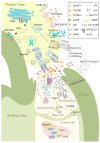The Role of Female and Male Genes in Regulating Pollen Tube Guidance in Flowering Plants
- PMID: 39596567
- PMCID: PMC11593715
- DOI: 10.3390/genes15111367
The Role of Female and Male Genes in Regulating Pollen Tube Guidance in Flowering Plants
Abstract
In flowering plants, fertilization is a complex process governed by precise communication between the male and female gametophytes. This review focuses on the roles of various female gametophyte cells-synergid, central, and egg cells-in facilitating pollen tube guidance and ensuring successful fertilization. Synergid cells play a crucial role in attracting the pollen tube, while the central cell influences the direction of pollen tube growth, and the egg cell is responsible for preventing polyspermy, ensuring correct fertilization. The review also examines the role of the pollen tube in this communication, highlighting the mechanisms involved in its growth regulation, including the importance of pollen tube receptors, signal transduction pathways, cell wall dynamics, and ion homeostasis. The Ca2+ concentration gradient is identified as a key factor in guiding pollen tube growth toward the ovule. Moreover, the review briefly compares these communication processes in angiosperms with those in non-flowering plants, such as mosses, ferns, and early gymnosperms, providing evolutionary insights into gametophytic signaling. Overall, this review synthesizes the current understanding of male-female gametophyte interactions and outlines future directions for research in plant reproductive biology.
Keywords: female gametophyte; pollen tube guidance; polyspermy; polytubey block.
Conflict of interest statement
The authors declare no conflicts of interest.
Figures


Similar articles
-
Female gametophyte-controlled pollen tube guidance.Biochem Soc Trans. 2010 Apr;38(2):627-30. doi: 10.1042/BST0380627. Biochem Soc Trans. 2010. PMID: 20298233 Review.
-
Dynamics of the cell fate specifications during female gametophyte development in Arabidopsis.PLoS Biol. 2021 Mar 26;19(3):e3001123. doi: 10.1371/journal.pbio.3001123. eCollection 2021 Mar. PLoS Biol. 2021. PMID: 33770073 Free PMC article.
-
She's the boss: signaling in pollen tube reception.Curr Opin Plant Biol. 2011 Oct;14(5):622-7. doi: 10.1016/j.pbi.2011.07.012. Epub 2011 Aug 18. Curr Opin Plant Biol. 2011. PMID: 21855398 Review.
-
Pathfinding in angiosperm reproduction: pollen tube guidance by pistils ensures successful double fertilization.Wiley Interdiscip Rev Dev Biol. 2012 Jan-Feb;1(1):96-113. doi: 10.1002/wdev.6. Epub 2011 Nov 18. Wiley Interdiscip Rev Dev Biol. 2012. PMID: 23801670 Review.
-
Female gamete competition in an ancient angiosperm lineage.Proc Natl Acad Sci U S A. 2011 Jul 26;108(30):12360-5. doi: 10.1073/pnas.1104697108. Epub 2011 Jun 20. Proc Natl Acad Sci U S A. 2011. PMID: 21690400 Free PMC article.
Cited by
-
Ovule development and pollen tube growth in Tsuga chinensis: insights into the evolution of siphonogamy.Plant Cell Rep. 2025 May 26;44(6):132. doi: 10.1007/s00299-025-03519-5. Plant Cell Rep. 2025. PMID: 40418382
References
Publication types
MeSH terms
Substances
Grants and funding
LinkOut - more resources
Full Text Sources
Miscellaneous

